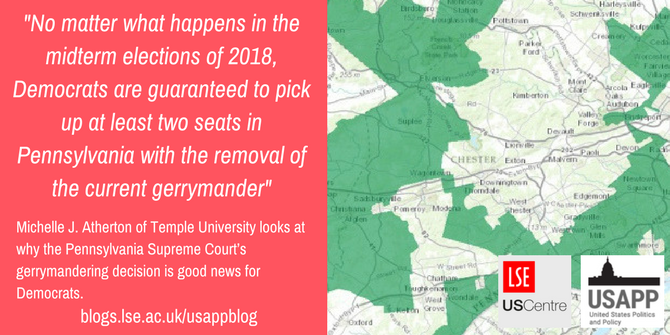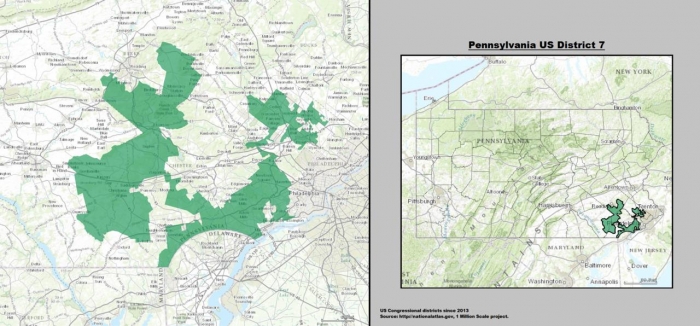 On January 22nd, the Pennsylvania Supreme Court threw out the Congressional District maps drawn by the state legislature in 2011, citing that they were in violation of the state’s constitution. Michelle J. Atherton writes that the decision has caused an earthquake in the state’s politics, with the Republican-controlled legislature now scrambling to come up with a fairer map for the Democratic Governor’s signature before February 9th. Whatever this map ends up looking like, she argues, it will almost certainly favor the Democrats in the mid-term elections this coming November.
On January 22nd, the Pennsylvania Supreme Court threw out the Congressional District maps drawn by the state legislature in 2011, citing that they were in violation of the state’s constitution. Michelle J. Atherton writes that the decision has caused an earthquake in the state’s politics, with the Republican-controlled legislature now scrambling to come up with a fairer map for the Democratic Governor’s signature before February 9th. Whatever this map ends up looking like, she argues, it will almost certainly favor the Democrats in the mid-term elections this coming November.
Last week, the political world in the Commonwealth of Pennsylvania was turned upside down – or possibly right side up, depending on whether one asks a Democrat or a Republican. Though we are still waiting for an official opinion to be released, the Pennsylvania Supreme Court found in The League of Women Voters of Pennsylvania v. The Commonwealth of Pennsylvania that the Congressional district boundaries for the state drawn by the legislature in 2011 “clearly, plainly, and palpably” violate the state constitution. In a 5-2 decision, which just so happens to be the partisan composition of the court’s elected judges, Democrat and Republican, respectively, the court ordered the state legislature and the governor to enact a new map with districts that are “composed of compact and contiguous territory; as nearly equal in population as practicable; and which do not divide any county, city, incorporated town, borough, township, or ward, except where necessary to ensure equality of population.” There is one exception, the March 13 special election for the state’s 18th Congressional district – called after the resignation of former Congressman Tim Murphy due to scandal – will go forward with the current, albeit temporary, boundaries.
There is one wrinkle to the court’s plan: the timeline is particularly tight. Congressional districts in Pennsylvania are created through legislation which must pass the state House and Senate, and be signed by the governor. The Supreme Court ordered the General Assembly (controlled by Republicans) to present a plan to the governor (a Democrat) by February 9, and for the governor to submit it to the court by February 15. If this process proves fruitless, the court will draw up its own map by February 19. Petitions to get on the ballot for the primary May 15 begin circulating February 13, potentially before candidates and the public know where the district boundaries will be. Petition season is just a few weeks, ending March 6. Ask anyone working on a Congressional campaign, and the court’s decision has thrown the state’s races for the US House in November into chaos.

How did Pennsylvania get to be such a mess? Back in 2011, the state was fully under Republican control, with the GOP holding both chambers of the General Assembly and the Governor’s Office. Following federal law (and continuing the process started in 2008), the state’s Republicans embarked on redrawing the lines for Congress using the most recent Census data to create districts equal in population. Pennsylvania had lost one seat, going from 19 to 18 members in the US House. Accordingly, the legislature drew up a new map, which the plaintiffs in the case argued was designed to maximize the number of Republican districts. Pennsylvania is usually roughly evenly divided along party lines, but as of the 2012 election cycle, Republicans have continued to win the same 13 of 18 House districts in the state. Incredibly enough, Democrats collected more votes for the House in 2012 than Republicans, 50.3 percent to 48.8 percent, and still only managed 27.7 percent of the seats in Congress. The trend has continued through each election cycle, with Democrats receiving at a low 44.5 percent of the votes, but still the same five districts.
Since 2011, Pennsylvania has been a case study in the maddening effects of gerrymandering. For example, the map combined the areas of two popular Democrats in western Pennsylvania into one, such that neither could run anywhere else, and made winning the new district incredibly difficult. It is also home to one of the most (if not the most) gerrymandered Congressional districts in the country, the 7th, which, as Figure 1 shows, runs through the southeast section of the state in the densely populated Philadelphia suburbs all the way into Amish farm country. It spans five counties, sometimes connected by a single building. It even has a cute nickname as a result of its Rorschach-like qualities: “Goofy Kicking Donald Duck.” It was designed for a Republican to win, as were the other 12 districts.
Figure 1 – Map of Pennsylvania’s 7th Congressional District

By 1: GIS (congressional districts, 2013) shapefile data was created by the United States Department of the Interior. 2: Data was rendered using ArcGIS® software by Esri. 3: File developed for use on Wikipedia and elsewhere by 7partparadigm. [Public domain], via Wikimedia Commons
In finding for the plaintiffs, the Pennsylvania Supreme Court declared the 2011 maps violated the free expression and equal protection guarantees of the Pennsylvania Constitution. Citizens were purposefully corralled into districts in order to dilute their effectiveness, by either packing Democrats together, or separating them out, also called “cracking,” among Republican-leaning districts, all because of their prior voting behavior. Since the argument was not grounded in federal law, it is unlikely that the current request for a stay to the US Supreme Court from the legislature’s Republican leaders will go anywhere (though there are currently partisan gerrymandering decisions pending before the US Supreme Court for North Carolina and Wisconsin). The Republican leadership in the state House and Senate have already been denied a stay by the Pennsylvania Supreme Court.
Understandably, Republicans are arguing they have not been given enough time to get a responsible map through the legislative process, and that the Court is overstepping its powers into lawmaking territory. For his part, Governor Tom Wolf says his team is already working on district boundary proposals. Anyone with even a passing familiarity with current technological capabilities knows making a map is not all that time-consuming, or difficult. In fact, there’s an app for that, also known as Dave’s Redistricting App, free and open to the public. The folks at the website FiveThirtyEight have a number of possible maps based on competitiveness, compactness, and matching the partisan composition of the electorate.
No matter what happens in the midterm elections of 2018, Democrats are guaranteed to pick up at least two seats in Pennsylvania with the removal of the current gerrymander, and have a good chance at a few others. As for the special election in the 18th district this March, though the boundaries were drawn to make it easy for Republicans to win, whoever ends up holding the seat may find it harder than usual to keep with new borders. And the most gerrymandered district in the country, the 7th, just had its incumbent Congressman, Patrick Meehan, announce he will not be seeking reelection due to a sexual harassment scandal. Whether politics in the state have been turned right-side-up or upside-down might be determined by one’s party identification, but they do appear about to become more fair, and certainly, a lot more interesting.
Please read our comments policy before commenting.
Note: This article gives the views of the author, and not the position of USAPP – American Politics and Policy, nor the London School of Economics.
Shortened URL for this post: http://bit.ly/2BDIzfD
_________________________________
About the author
 Michelle J. Atherton- Temple University
Michelle J. Atherton- Temple University
Michelle J. Atherton is the associate director of the Institute for Public Affairs at Temple University and the senior policy writer and editor at its Center on Regional Politics. She has authored and co-authored white papers on such topics as municipal government, legislative reform in Pennsylvania, education policy and finance, and public pensions, and co-authored articles in State Politics and Policy Quarterly and State and Local Government Review. Atherton also co-edited a volume of Commonwealth: A Journal of Pennsylvania Politics and Policy where she serves as managing editor.






